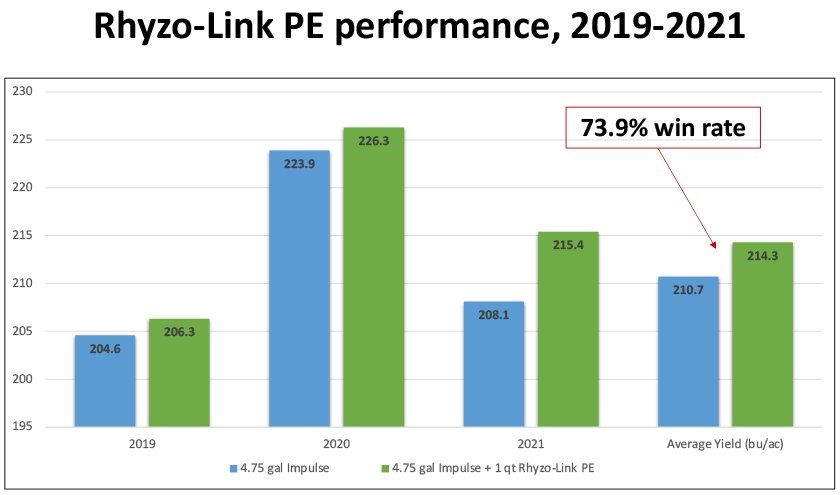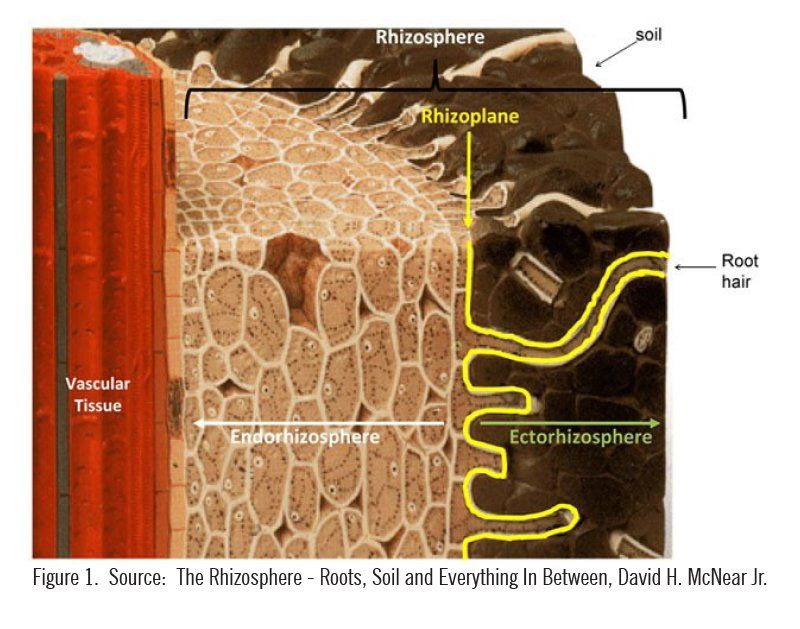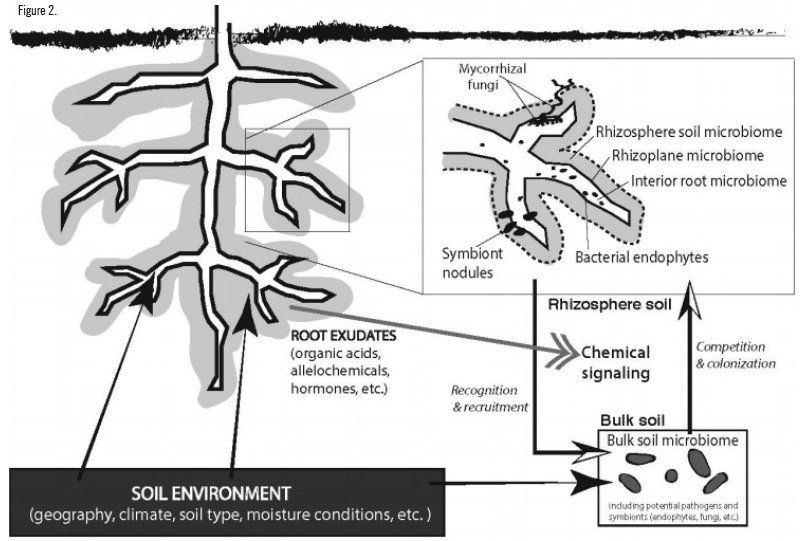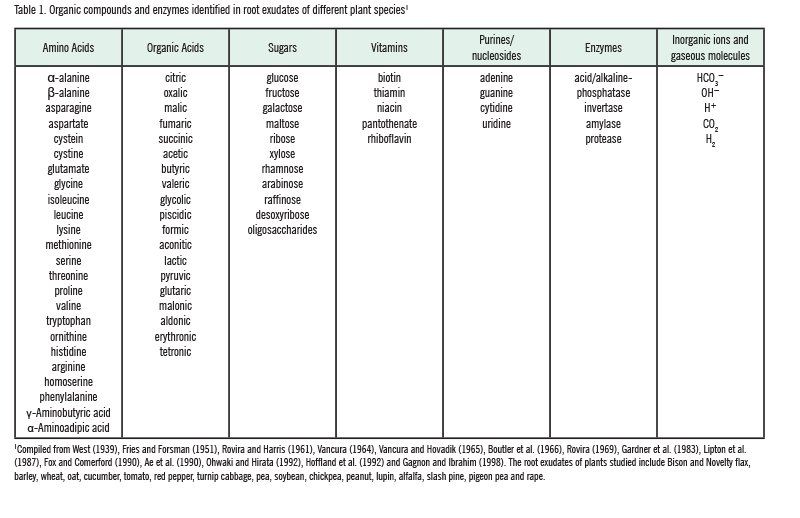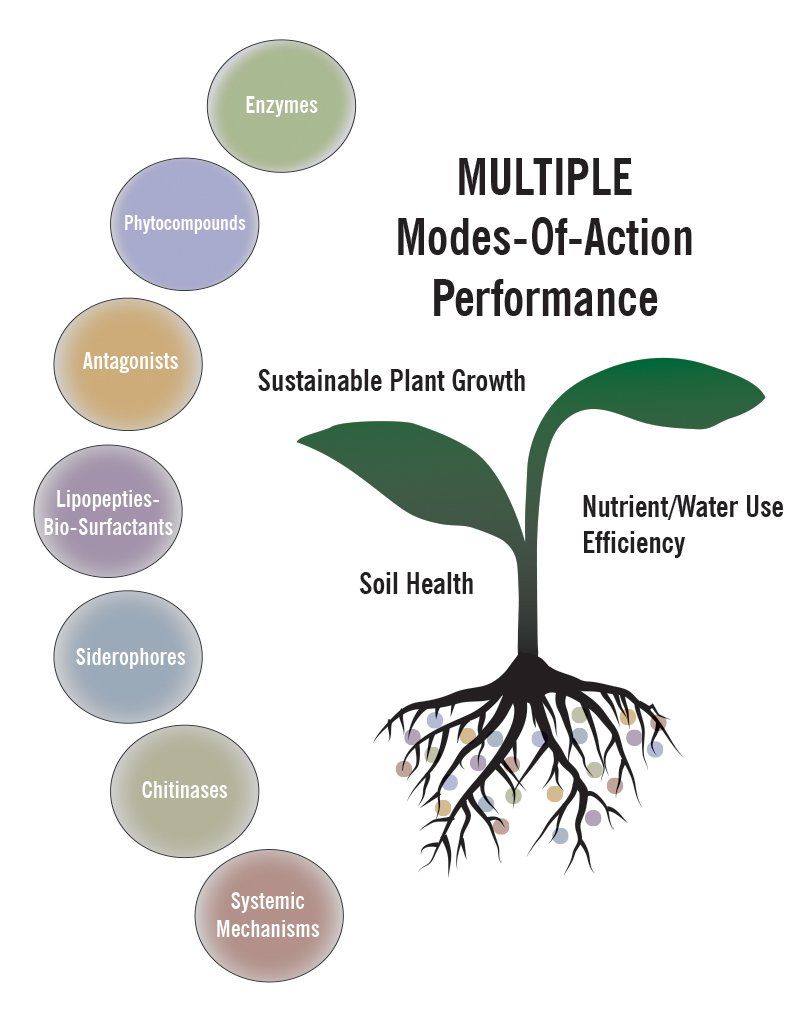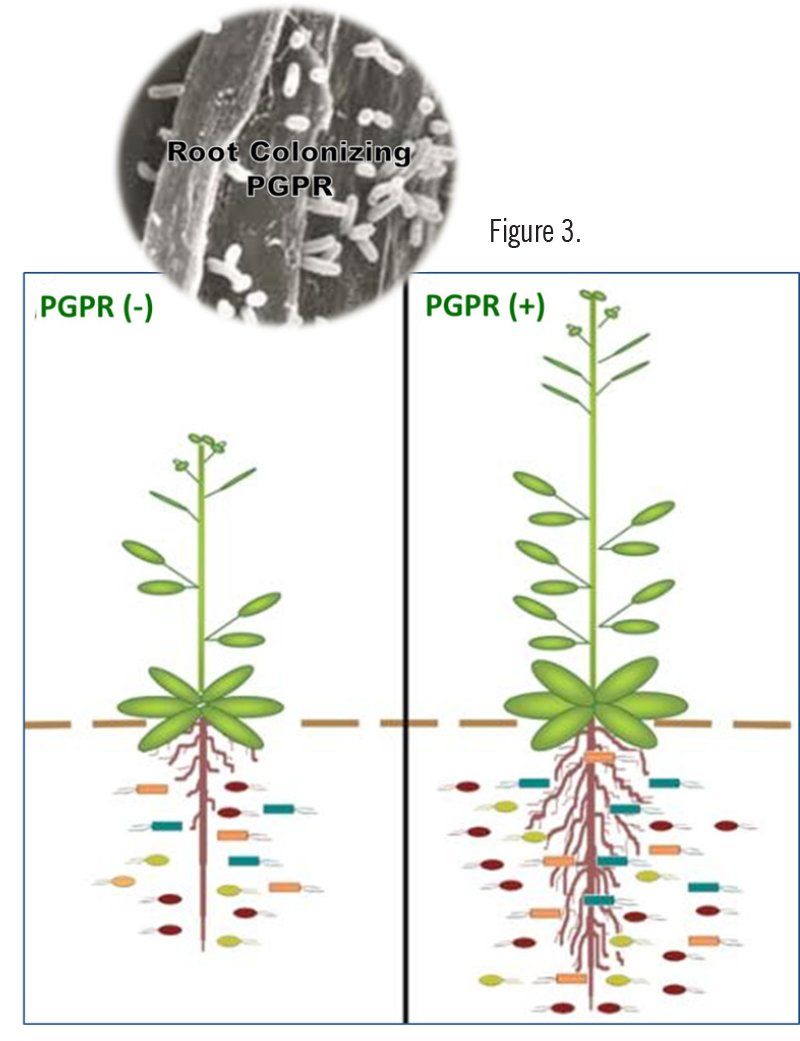Rise to your Potential®
with NACHURS Rhyzo-Link®
NACHURS Rhyzo-Link is a Proprietary Plant Growth Promoting Rhizobacteria (PGPR) technology paired with premium NPK fertilizer, delivering the highest concentration of multi-strain, pure culture rhizobacteria. Rhyzo-Link is also powered by NACHURS ® Bio-K ®: a unique potassium technology. This technology ultimately leads to increased soil and plant health benefits resulting in maximum and sustainable yield potential.

Features
- A complete package of high quality N-P-K-S, micronutrients, and PGPR
- Rhyzo-Link contains a multi-strain microbial component
- Rhyzo-Link is formulated with a pure culture PGPR
- Extended shelf-life for up to 18 months
- A unique nutrient delivery system
Benefits
- Consistent performance across a wide range of environmental conditions, resulting in greater productivity
- Wide range of product uses and applications
- Ease of use, inventory flexibility, stable product
- No issues with mixing, storability or shelf-life
NACHURS® Bio-K® technology is also included in the NACHURS® Rhyzo-Link® products
Bio-K is a premium source of potassium fertilizer combined with a natural plant metabolite; the most effective and efficient source of potassium. Using Bio-K technology results in quicker germination, improved root development, and an elevated abiotic stress tolerance; leading to better plant establishment, more vigorous growth, and higher yields.
The Technology
The microbiology in Rhyzo-Link products react synergistically within the rhizosphere and with the plant to promote beneficial responses that improve soil productivity and plant health along with crop performance.
Rhyzo-Link solutions are the next generation in plant fertility, combining a high quality NPK fertilizer with a pure culture, poly-microbial component (PGPR) for use in a wide range of environmental conditions and cropping systems. This fertility solution is designed to provide greater nutrient utilization and efficiency via increased plant biomass, as well as better adaptability to biotic and abiotic factors which occur through numerous physical, chemical, and environmental interactions. Rhyzo-Link solutions provide a buffering or moderating “link” between soil health/ chemistry and plant productivity through efficient balance, placement, and recovery of soil/plant nutrients.
Rhyzo-Link contains Plant Growth Promoting Rhizobacteria (PGPR) which is unique to the marketplace. It is a pure culture, multi-strain, poly-microbial solution formulated to enhance fertilizer solutions. It has the natural ability to improve nutrient utilization which helps the plant to better tolerate biotic and abiotic interactions. This is done through the production and ultimate release of secondary metabolites (i.e. enzymes, lipopeptides, biosurfactants, etc.) into the rhizosphere which then impact plant processes such as nutrient availability, root hair proliferation, and systemic mechanisms. Once applied to the rhizosphere and/or phyllosphere and absorbed by the plant, it helps to promote a healthy plant with a more pronounced root system, and ultimately helps to improve crop yield and productivity. Rhyzo-Link when incorporated into fertilizer solutions, truly becomes an easy to use fertility package.
With the plant signaling mechanism (triggered by environmental conditions) via the release of root exudates, to the ultimate production of beneficial plant metabolites by PGPR, soil and plant processes are “linked” together to result in increased growth and yield by the following actions:
- improved plant vigor and stand establishment
- improved handling of biotic and abiotic interactions
- improved nutrient uptake and efficiency
- improved soil health and water use efficiency
- improved adaptive and coping mechanisms
- improved flowering and fruit quality
This all leads to increased plant yield and productivity.

The Science
Soil Rhizosphere Defined
NACHURS Rhyzo-Link is designed to build a healthy soil rhizosphere which can support increased plant growth and productivity. The rhizosphere is the narrow region of soil that is directly influenced by root secretions and associated soil microorganisms
(see Figure 1.).
The rhizosphere contains many bacteria that feed on sloughed-off plant cells, and the proteins and sugars released by roots (root exudates). Protozoa and nematodes that graze on bacteria are also more abundant in the rhizosphere. Much of the nutrient cycling needed by plants occurs immediately adjacent to roots.
Plant/Rhizosphere Interactions
Due to many factors, the rhizosphere is a desirable environment for the growth and proliferation of many organisms (beneficial and non-beneficial) which have both positive and negative effects on plant growth and development. These beneficial organisms include symbiotic bacteria (rhizobium ssp.), mychorrhizal fungi, and plant growth promoting rhizobacteria (PGPR) just to name a few (see Figure 2.).
Plants have naturally evolved a survival mechanism to change root morphology as environmental conditions change. This is done by altering the composition of root exudates, which changes the chemical environment of the rhizosphere and also acts as a signal compound to beneficial microorganisms.
Root exudates include secretions which are actively released from the root, diffusates which are passively released due to an osmotic gradient, and lysates from cortical/epidermal cells in the root (see Table 1.). These root exudates include a wide variety of amino acids, sugars, organic acids, proteins, etc., which are then utilized by microorganisms as a food source. In turn, these beneficial microorganisms release metabolites which are used by the plant to further growth and development. In short, NACHURS Rhyzo-Link solutions help to provide an environmental balance between soil and plant by “linking” cycles and processes that occur in the soil and plant together.
How do PGPRs Work?
Similar to fermentation, where microbes assimilate sugars and exude alcohols, our unique blend of PGPR’s transform sugars and other nutrients into useful metabolites. These include:
- Phytocompounds
- Siderophores
- Lipopeptides
- Microbial Antagonists
- Enzymes
- Systemic Triggers
- Chitinases
These metabolites immediately go to work in the soil to enhance nutrient uptake, lateral root growth, root hair proliferation, biotic and abiotic functionality, and systemic mechanisms within the plant, just to name a few. When the sporulated bacteria are placed in an environment which is conducive to growth, they come out of their “protective shell” and rapidly expand in number and begin producing these metabolites.
The initial deployment form of the PGPR is a bacterial endospore. The endospore is a survival mechanism employed by gram positive bacteria, including those contained in Rhyzo-Link®. The spore can be considered a defensive structure enabling the bacteria to survive under conditions too harsh for survival of the vegetative cell, which include:
- starvation
- high temperature
- pH extremes
- salt environments
- toxic chemicals
Once these bacterial endospores “germinate”, they begin normal multiplication and colonization of the rhizosphere (see Figure 3.). This gives rise to increased root and shoot growth, lateral root and root hair development, increased leaf surface area and chlorophyll content, and higher plant productivity.
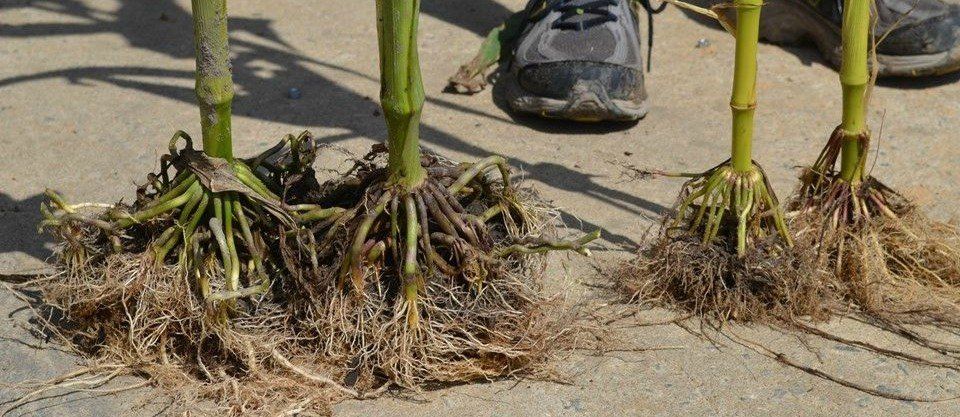
Rhyzo-Link 3-10-13 in-furrow, left. No in-furrow starter, right.
Specific Role of Metabolites
As stated previously, PGPRs transform root exudates into beneficial metabolites which are used in a variety of plant and/or soil processes, resulting in increased plant productivity.
Phosphate Utilization Enzymes
Antagonists and Lytic Enzymes
Antioxidative Enzymes
Pure Culture, Multi-Strain, Poly-Microbial Science
NACHURS Rhyzo-Link utilizes the latest advancements in microbial technology and pure culture science to provide enhanced plant nutrient uptake and availability via the production of rooting and meristematic compounds, antioxidants, enzymes, biosurfactants, lipopeptides, etc. and the stimulation of systemic mechanisms.
Note: Strains are not limited to the specific functions listed. NACHURS Rhyzo-Link products are formulated with diverse PGPR and microbial active ingredients providing redundancy for each reaction in the rhizosphere. This bio-redundancy insures desired in-soil reactions are performed and metabolic pathways within the plant are optimized under varying environmental conditions.
Primary function:
- Improved nutrient utilization (phosphorus, carbon, organic matter) through breakdown and enhanced availability
Secondary benefit:
- Plant growth promotion
- Stress mitigation
- Heavy metal/salt tolerance
| Bacillus teqilensis | Bacillus velezensis | Enzyme assay | Function | Benefit to Plant |
|---|---|---|---|---|
| Yes | Yes | Alkaline phosphatase | Organic phosphorus conversion | Primary |
| Yes | Yes | Esterase | Diminish toxic effects of heavy metals and salts | Secondary |
| Yes | Yes | Esterase lipase | Plant growth promotion | Secondary |
| No | Yes | Trypsin | Peptide hydrolysis | Primary |
| No | Yes | a-chymotrysin | Peptide hydrolysis | Primary |
| Yes | Yes | Acid phosphatase | Inorganic phosphorus conversion | Primary |
| Yes | Yes | Naphthol As-Bi-phophohyrolase | Release of nutrients bound in manure | Primary |
| Yes | No | α-galactosidase | Breakdown of oligosaccharides and polysaccharides | Primary |
| Yes | Yes | α-glucosidase | Conversion of carbohydrates to sugar | Secondary |
| Yes | Yes | β-glucosidase | Stress Tolerances | Secondary |
| Yes | Yes | Amylase | Degradation of organic matter | Primary |
| Yes | Yes | Protease | Stress tolerance | Secondary |
| Yes | Yes | Celluase | Degradation of cellulose and carbon | Primary |
